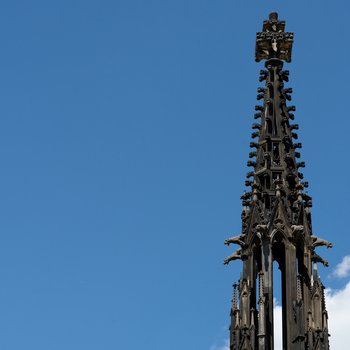Plague, cholera and corona - epidemics yesterday and today (2023)
Epidemics have presented mankind with challenges at all times, but have also triggered social change and medical progress. Coins and medals serve to shed light on the epidemics of the past and present in terms of how they were perceived by their contemporaries, their fears and hopes.
Diseases are not only something that artists pick up on; they are also an important indicator for archaeological researchers. The traces they leave behind offer clues to the circumstances and ways in which people lived, playing a material role in proto-historic research.

From 1840 to 1841, the city of Dresden escaped an outbreak of cholera, probably thanks to measures that had been taken. Shortly after, on 5 November 1841, Captain Eugen Freiherr von Gutschmid, a baron, art patron and honorary member of the Royal Saxon Academy of the Arts, commissioned the architect Gottfried Semper to design and build a monument to the event in “Gothic style”; the architectural style to which Gutschmid himself was most attached.

Coins and medals are important witnesses of ancient epidemics. You can currently get an idea of this in the Numismatic Collection. In this article, the curator of the exhibition explains the significance of epidemics to the ancient world.
![[Translate to English:] Plague in an Ancient City (Michiel Sweerts) [Translate to English:] Oil painting showing a multitude of people in an ancient city street. People are praying, talking and suffering. In the foreground lie some who seem dead or near death.](/fileadmin/_processed_/3/5/csm_Plague_in_an_Ancient_City_LACMA_AC1997.10.1__1_of_2__c5e3e66c02.jpg)
What we can learn from coins and medals goes far beyond discovering hidden hoards or studying the economic consequences of events. Such artefacts also tell us about societies’ beliefs, hopes and fears. Currently, an exhibition at the Münzkabinett (Numismatic Collection) is devoted to the connection between coins and epidemics. Curator Ilka Hagen explains here what one has to do with the other.
![[Translate to English:] Asklepios and Telesphoros [Translate to English:] Bronze medal, the relief of which shows the holy Asclepius. On the right he holds a large, almost club-like staff towards the ground, with the snake coiling around it (Asclepius' or Asclepius' staff), in front of his left stands the small Telesphoros with hood and cape. The inscription reads: "ECOLES DE MEDECINE".](/fileadmin/_processed_/4/c/csm_1a_502b95e988.jpg)